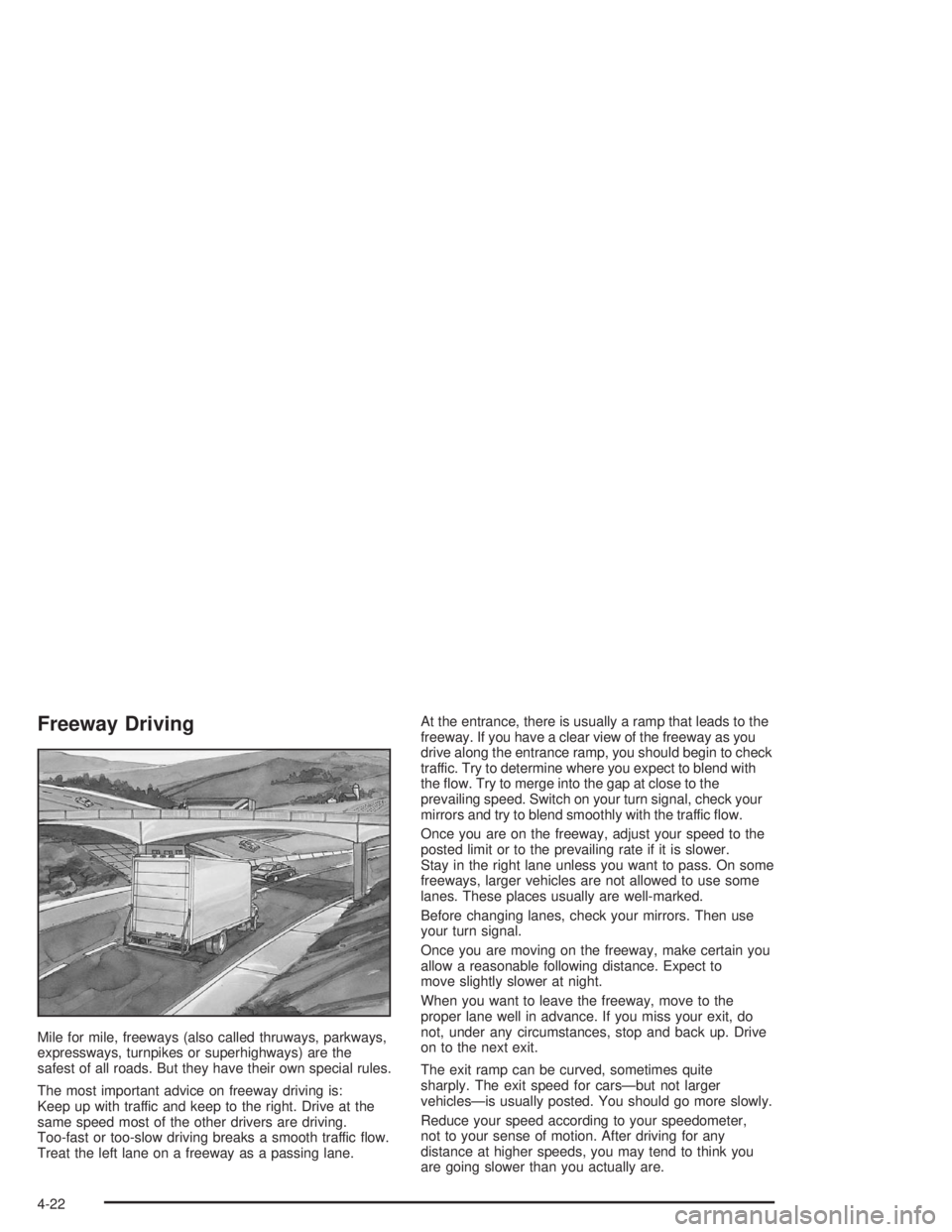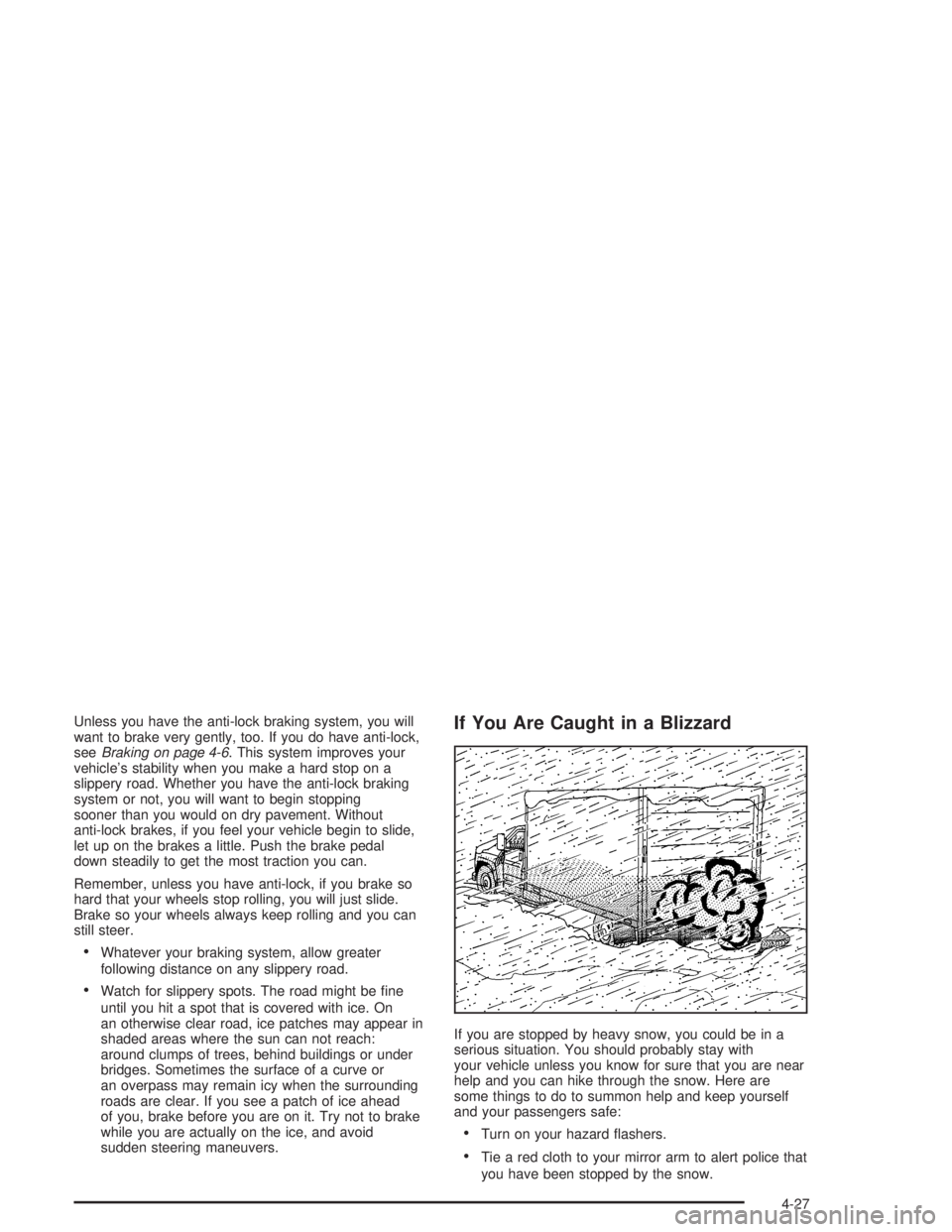2004 CHEVROLET KODIAK mirror
[x] Cancel search: mirrorPage 192 of 366

Freeway Driving
Mile for mile, freeways (also called thruways, parkways,
expressways, turnpikes or superhighways) are the
safest of all roads. But they have their own special rules.
The most important advice on freeway driving is:
Keep up with traffic and keep to the right. Drive at the
same speed most of the other drivers are driving.
Too-fast or too-slow driving breaks a smooth traffic flow.
Treat the left lane on a freeway as a passing lane.At the entrance, there is usually a ramp that leads to the
freeway. If you have a clear view of the freeway as you
drive along the entrance ramp, you should begin to check
traffic. Try to determine where you expect to blend with
the flow. Try to merge into the gap at close to the
prevailing speed. Switch on your turn signal, check your
mirrors and try to blend smoothly with the traffic flow.
Once you are on the freeway, adjust your speed to the
posted limit or to the prevailing rate if it is slower.
Stay in the right lane unless you want to pass. On some
freeways, larger vehicles are not allowed to use some
lanes. These places usually are well-marked.
Before changing lanes, check your mirrors. Then use
your turn signal.
Once you are moving on the freeway, make certain you
allow a reasonable following distance. Expect to
move slightly slower at night.
When you want to leave the freeway, move to the
proper lane well in advance. If you miss your exit, do
not, under any circumstances, stop and back up. Drive
on to the next exit.
The exit ramp can be curved, sometimes quite
sharply. The exit speed for cars—but not larger
vehicles—is usually posted. You should go more slowly.
Reduce your speed according to your speedometer,
not to your sense of motion. After driving for any
distance at higher speeds, you may tend to think you
are going slower than you actually are.
4-22
Page 193 of 366

Highway Hypnosis
Is there actually such a condition as “highway
hypnosis”? Or is it just plain falling asleep at the wheel?
Call it highway hypnosis, lack of awareness, or
whatever.
When you drive the vehicle for a long distance, there is
something about an easy stretch of road with the
same scenery, along with the hum of the tires on the
road, the drone of the engine, and the rush of the wind
against the vehicle that can make you sleepy. Do
not let it happen to you! If it does, your vehicle can leave
the road inless than a second,and you could crash
and be injured.
What can you do about highway hypnosis? First, be
aware that it can happen.
Then here are some tips:
•Make sure your vehicle is well ventilated, with a
comfortably cool interior.
•Keep your eyes moving. Scan the road ahead and
to the sides. Check your mirrors and your
instruments frequently.
•If you get sleepy, pull off the road into a rest,
service or parking area and take a nap, get some
exercise, or both. For safety, treat drowsiness
on the highway as an emergency.
Hill and Mountain Roads
Driving on steep hills or mountains is different from
driving in flat or rolling terrain.
4-23
Page 197 of 366

Unless you have the anti-lock braking system, you will
want to brake very gently, too. If you do have anti-lock,
seeBraking on page 4-6. This system improves your
vehicle’s stability when you make a hard stop on a
slippery road. Whether you have the anti-lock braking
system or not, you will want to begin stopping
sooner than you would on dry pavement. Without
anti-lock brakes, if you feel your vehicle begin to slide,
let up on the brakes a little. Push the brake pedal
down steadily to get the most traction you can.
Remember, unless you have anti-lock, if you brake so
hard that your wheels stop rolling, you will just slide.
Brake so your wheels always keep rolling and you can
still steer.
•Whatever your braking system, allow greater
following distance on any slippery road.
•Watch for slippery spots. The road might be fine
until you hit a spot that is covered with ice. On
an otherwise clear road, ice patches may appear in
shaded areas where the sun can not reach:
around clumps of trees, behind buildings or under
bridges. Sometimes the surface of a curve or
an overpass may remain icy when the surrounding
roads are clear. If you see a patch of ice ahead
of you, brake before you are on it. Try not to brake
while you are actually on the ice, and avoid
sudden steering maneuvers.
If You Are Caught in a Blizzard
If you are stopped by heavy snow, you could be in a
serious situation. You should probably stay with
your vehicle unless you know for sure that you are near
help and you can hike through the snow. Here are
some things to do to summon help and keep yourself
and your passengers safe:
•Turn on your hazard flashers.
•Tie a red cloth to your mirror arm to alert police that
you have been stopped by the snow.
4-27
Page 295 of 366

Fuse Usage
RH PARK LP Right-hand Parking Lamps
LH PARK LP Left-hand Parking Lamps
RADIO U Radio
PWR WINDOW Power Windows
BRAKE ISO Brake Warning Lamp
SPARE Spare Fuse
L-RR TRUCK Left Rear Trailer Wiring
SPARE Spare Fuse
SPARE Spare Fuse
SPARE Spare Fuse
R-RR TRUCK Right Rear Trailer Wiring
SPARE Spare Fuse
Relay Usage
BRAKE LAMPC4/C5 Brake Lamps,
C6/C7/C8 Tractor/Trailer Wiring
IGN 4 IgnitionRelay Usage
MARKER LP Sidemarker and Clearance Lamps
HTD FUEL LB7/LG4 Heated Fuel
AIR HTR LG4 Air Heater
ECU MAINTAIN LG4 Electronic Control Unit
DRL Daytime Running Lamps
CHMSL ISO Center High Mounted Stop Lamp
HTD MIRR Heated Mirrors
R-TRN TLR Right Trailer Turn Signal
L-TRN TLR Left Trailer Turn Signal
SPARE Spare Relay
SPARE Spare Relay
SPARE Spare Relay
5-89
Page 337 of 366

Exhaust System Check
Be alert for any changes in the sound of the exhaust
system or any smell of fumes. These are signs the
system may be leaking. Have it checked and/or repaired
at once. Refer toEngine Exhaust on page 2-37and
Running Your Engine While You Are Parked on
page 2-38.
Windshield Wipers and Washers Check
Check operation and condition of the wiper blades.
Check the flow of the washer spray.
Defroster Check
Move the control to the defrost symbol and the fan to HI
or the high symbol. Then check the airflow from the
ducts at the inside base of the windshield.
Mirrors and Sun Visors Check
Check that friction joints hold mirrors and sun visors in
place.
Seat Adjuster Check
When adjusting a manual seat, be sure seat adjusters
latch by attempting to move the seat after latching.
Lamps Check
Check panel lighting, warning lights, indicator lights and
interior lamps. On the outside, check: license plate
lamps, sidemarker lamps, reflectors or lights on outside
mirrors, headlamps, parking lamps, identification and
clearance lamps, taillamps, brake lamps, turn signals,
backup lamps and hazard warning flashers. Have
headlamp aim checked at once if beams seem
improperly aimed.
Glass, Mirrors, Lamps and/or
Re�ectors Condition Check
Look for broken, scratched, dirty or damaged glass,
mirrors, lamps or reflectors that could reduce the view
or visibility or cause injury. Replace, clean or repair
promptly.
Door Latches Check
Check that doors close, latch and lock tightly. Check for
broken, damaged or missing parts that might prevent
tight latching.
6-27
Page 357 of 366

G
Gage
Air Pressure...............................................3-44
Check Gages Warning Light..........................3-42
Engine Coolant Temperature.........................3-35
Filter Minder...............................................3-44
Fuel..........................................................3-42
Hourmeter..................................................3-45
Oil Pressure...............................................3-37
Speedometer..............................................3-25
Tachometer.................................................3-26
Transmission Temperature.............................3-40
Voltmeter Gage...........................................3-30
Gasoline
Octane........................................................ 5-6
Specifications............................................... 5-6
Gasoline Engine, Starting.................................2-12
Gasoline Engine Warm-Up...............................2-14
Glass, Mirrors, Lamps and/or Reflectors
Condition Check..........................................6-27
H
Hazard Warning Flashers................................... 3-5
Headlamp High/Low-Beam Changer.................... 3-8
Headlamp Wiring............................................5-86Headlamps On Reminder.................................3-13
Heavy-Duty Trailer Wiring Package....................4-35
Height Adjustment............................................. 1-6
High Idle System (Caterpillar
®Diesel and
Gasoline Engines).......................................2-16
Highway Hypnosis...........................................4-23
Hill and Mountain Roads..................................4-23
Hood
Checking Things Under................................5-18
Latches......................................................5-19
Hood Latches Check.......................................6-28
Horn............................................................... 3-6
Hourmeter Gage.............................................3-45
How to Add Coolant to the Coolant
Surge Tank.................................................5-39
How to Add Fluid............................................5-32
How to Check................................................5-69
How to Check and What to Use...............5-31, 5-32
How to Check Fluid........................................5-61
How to Check Lubricant...................................5-61
How To Check Power Steering Fluid..................5-43
How to Inspect the Engine Air Cleaner/Filter.......5-30
How to Use This Manual...................................... ii
How to Wear Safety Belts Properly...................1-13
Hydraulic Brake System
Warning Lights............................................3-32
Hydraulic Brake Systems................................... 4-6
Hydraulic Brakes.............................................2-33
Hydroplaning..................................................4-20
7
Page 360 of 366

Matching Transmitter(s) to Your Vehicle............... 2-5
Mexico, Central America and Caribbean
Islands/Countries (Except Puerto Rico and
U.S. Virgin Islands)....................................... 7-4
Mirrors
Manual Rearview Mirror................................2-39
Outside Convex Mirrors................................2-40
Outside Heated Mirrors................................2-41
Outside Manual Mirrors................................2-39
Outside Power Mirrors..................................2-40
Mirrors and Sun Visors Check..........................6-27
Model Reference................................................ vi
Moisture Ejector..............................................5-50
MyGMLink.com................................................ 7-3
N
New Vehicle Break-In......................................2-11
Noise Control System, Tampering......................5-62
Normal Maintenance Replacement Parts...........5-100
O
Odometer......................................................3-25
Off-Road Recovery..........................................4-14Oil
Change Engine Oil Light...............................3-39
Engine...............................................5-20, 5-25
Low Oil Level Light......................................3-38
Pressure Gage............................................3-37
Older Children, Restraints................................1-27
Online Owner Center........................................ 7-3
Other Service Items
Air Conditioning System...............................5-67
Automatic Ether Injection System...................5-66
Front Wheel Bearings with Oil-Filled Hubs.......5-67
Fuel Filter...................................................5-64
Primary Fuel Filter and Water Separator.........5-65
Secondary Fuel Filter and Water Separator/
Heater....................................................5-66
Other Warning Devices...................................... 3-6
Outlet Adjustment............................................3-22
Outside
Convex Mirrors............................................2-40
Heated Mirrors............................................2-41
Manual Mirrors............................................2-39
Power Mirrors.............................................2-40
Overdrive Defeat.............................................2-29
Overspeed Warning Light.................................3-39
Owners, Canadian............................................... ii
Owner’s Information.......................................... 7-8
10
Page 362 of 366

Rear Seat Outside Passenger Positions
(Crew Cab Models)....................................1-23
Rear Seat Passengers, Safety Belts..................1-23
Rear Wheel Park Brake Burnish Procedure........2-34
Rear Window Defogger....................................3-21
Rearview Mirrors.............................................2-39
Reclining Seatbacks.......................................... 1-4
Reduced Engine Power Light............................3-41
Releasing Air-Operated Parking Brakes..............4-31
Remote Keyless Entry System............................ 2-3
Remote Keyless Entry System, Operation............ 2-4
Replacement Bulbs.........................................5-63
Replacing Brake System Parts..........................5-49
Replacing Restraint System Parts
After a Crash..............................................1-62
Reporting Safety Defects
Canadian Government................................... 7-7
General Motors............................................. 7-7
United States Government.............................. 7-6
Restarting the Diesel Engine While Moving
(Automatic Transmission)..............................2-15
Restarting the Gasoline Engine While Moving
(Automatic Transmission)..............................2-14
Restraint System Check...................................6-25
Checking Your Restraint Systems...................1-61
Replacing Restraint System Parts
After a Crash..........................................1-62Restraint Systems
Checking....................................................1-61
Replacing Parts...........................................1-62
Resynchronization............................................. 2-6
Right Front Passenger Position, Safety Belts......1-22
Rims and Wheels...........................................5-69
Roadside
Assistance Program....................................... 7-4
Rocking Your Vehicle To Get It Out...................4-30
Routing, Engine Drive Belt..............................5-103
Running Out of Fuel........................................5-15
Running Your Engine While You Are Parked.......2-38
S
Safety Belt
Reminder Light............................................3-26
Reminder Tone............................................3-26
Safety Belts
Care of......................................................5-79
Center Passenger Position............................1-22
Driver Position............................................1-13
How to Wear Safety Belts Properly................1-13
Questions and Answers About Safety Belts.....1-12
Rear Seat Passengers.................................1-23
Right Front Passenger Position......................1-22
12